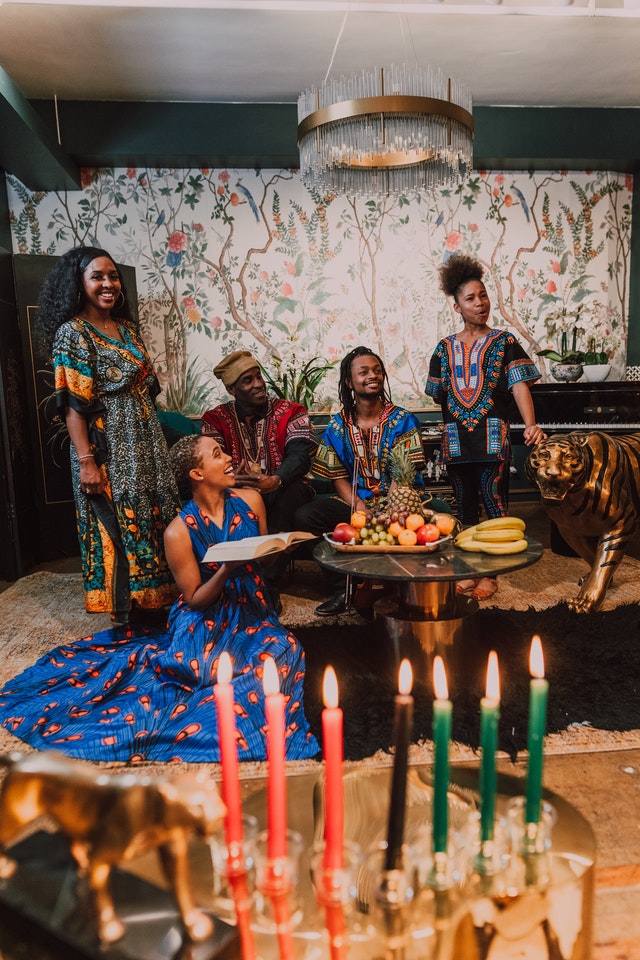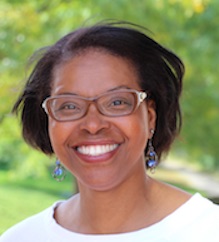Happy Kwanzaa!
by Dr. Fari Nzinga (editorial support from Dr. Regina Stevens-Truss)
Happy Holidays! This is the time of year when millions of people will wish each other a Merry Christmas, happy Solstice or happy Hannukah. Some may even say happy Kwanzaa… but, how many know it’s roots or know someone who celebrates it? [FYI – Oprah, Maya Angelou, Chuck D, Angelina Jolie, and Synthia Saint James (who designed the first Kwanzaa postage stamp in 1997), all celebrate it]
So, what is Kwanzaa anyway, you ask?
Kwanzaa is a festival that takes place annually from December 26th to January 1st. I know what you’re thinking, but it was not meant to replace Christmas. In 1966, after a rather tumultuous year of violent social unrest in Los Angeles – Watts especially – Maulana Karenga, a young Black man involved with activist groups like the Student Nonviolent Coordinating Committee (SNCC) and the Black Panthers, was one of many Black youngsters who had been starved of information about his past and was intellectually curious about African peoples’ histories and civilizations. Wanting to marry scholarship in Black and Africana studies with direct action and other forms of activism, Karenga turned his attention to the political possibilities of Black and African culture. One of his first cultural projects was the creation of Kwanzaa, a secular, week-long celebration of African heritage, culture and philosophy.
The name Kwanzaa comes from the Swahili phrase, “matunda ya kwanza,” meaning “first fruits.” Kwanzaa is a holiday that draws inspiration from traditional harvest festivals celebrated throughout Africa (it is important to note that although over 2000 languages are spoken on the African continent, Swahili is spoken by millions on the continent and was adopted as the unifying language of Kwanzaa). Karenga sought to emphasize that the basic principles found in producing the harvest are vital to building and maintaining strong and wholesome communities.

The primary symbols of Kwanzaa can be seen in the Kwanzaa Table Candles image from gettyimages: the mkeka, a woven straw mat symbolizing how African heritage builds upon tradition; the kinara, a seven-space candle holder, representing the original stalk from which the African people originated; the mishumaa sabaa, the seven candles displayed (black, red, and green based on the colors of the Pan-African flag) and used in the candle lighting ceremony (more on this to follow below), represent the seven principles described below; the kikombe cha umoja is the cup with which to pour libations; the muhindi are the ears of corn which represent the offspring (children) of the stalk (parents of the house); and the zawadi (gifts) represent the fruits of the labor of the parents and the rewards of seeds sown by the children.
Each day of Kwanzaa corresponds with a principle upon which celebrants reflect. The seven principles (described below) representing the seven days are known as the Nguzo Saba. During the celebration of Kwanzaa, it is customary to greet friends and family with the Swahili phrase, “Habari gani“, meaning, “What’s the news?” In response, one answers with the principle of the day (Umoja, for example, is the response given on December 26th):
Umoja (unity) – to strive for and maintain unity in the family, community, nation, and race.
Kujichagulia (self-determination) – to define ourselves, name ourselves, and speak for ourselves.
Ujima (collective work and responsibility) – to build and maintain our community together and to make our brothers and sisters problems our problems and to solve them together.
Ujamaa (cooperative economics) – to build and maintain our own stores, shops and other businesses and to profit together from them.
Nia (purpose) – to make as our collective vocation the building and developing of our community in order to restore our people to their traditional greatness.
Kuumba (creativity) – to do always as much as we can, in the way we can in order to leave our community more beautiful and beneficial than when we inherited it.
Imani (faith) – to believe with all our heart in our parents, our teachers, our leaders, our people and the righteousness and victory of our struggle.
So, what happens during the 7 days of Kwanzaa, you ask?
Well, the National Museum of African Art and the Anacostia Museum describe the candle lighting ceremony, which is central to the celebration of Kwanzaa observance and which reinforces the meaning of the seven principles, as follows:
Each night (from Dec 26 to Jan 1) at a time when all members of the family are present – children are encouraged to take an active role in all activities – a candle is lit.
Day 1 (Dec 26) – the ceremony begins with the lighting of the black candle and TAMBIKO (libation), which an African form of praise which pays homage to personal and collective ancestors. The elder of the household pours wine, juice or distilled spirits from the KIKOMBE CHA UMOJA (unity cup) into the earth or an earth-filled vessel, and while pouring, the elder makes a statement honoring departed family members for the inspiration and values they have left with their descendants. Friends are also remembered.
After the TAMBIKO, as a gesture of unity, the elder drinks and then passes the unity cup around for all to share, while leading the call, “HARAMBEE” (let’s pull together), and everyone participates in repeating the phrase seven times.
Following the lighting of the first candle on day one “The candles are lit beginning with the black candle (always the black candle that represents Black people) on day one; followed by a red candle, representing the struggle of the people, on day two; then on day three a green candle is lit, representative of the future” (Oprah Magazine, The Principles and Meaning of Kwanzaa). The remaining candles are then lit, alternately, with the final one on January 1st. After each candle lighting, the principle of the day is discussed.
The evening of December 31 (Day 6) is the KARAMU (feast), a joyous celebration with food, drink, dance, and music for the collective family and friends. It is a time of rejoicing, reassessment and recommitment.
Day 7 (January 1) is reserved for SIKA YA TAAMULI, a day or meditation or assessment used by people to reflect on their lives.

Now, although Kwanzaa is a secular holiday, that does not mean that it is necessarily an apolitical one. The colors red, black and green are especially important and communicate Kwanzaa’s Pan-African political sentiment. Back in 1920, infamous Jamaican immigrant and Harlem resident, Marcus Garvey created the Pan-African flag (also referred to as the Black liberation flag) consists of three horizontal bars, one red, one black and one green. Garvey, also the founder and leader of the Universal Negro Improvement Association (UNIA), the largest pro-Black political organization in the world, said in a 1921 speech that appeared in the Negro World newspaper: “Show me the race or the nation without a flag, and I will show you a race of people without any pride. Aye!” In song and mimicry they have said, “Every race has a flag but the coon.” How true! Aye!” Garvey saw the flag as a sign of political maturity, a manifestation of resistance to oppression, and a source of racial pride. According to Garvey, the red symbolizes the blood of martyrs, the black symbolizes the skin of Africans, and the green represents the vegetation of the African land (Marcus Garvy, Wikipedia)
While plenty of people think of Kwanzaa as an Afrocentric Christmas knock-off (if they think of Kwanzaa at all that is), plenty more have turned to the holiday as a much-needed reprieve from the demands of contemporary consumer culture. This holiday season, whether you choose to celebrate Kwanzaa or not, spend a little time reflecting on how YOU are contributing to the cause of Black liberation.
Here is wishing everyone happy holidays, and especially this year, happy Kwanzaa!
Regina Stevens-Truss


